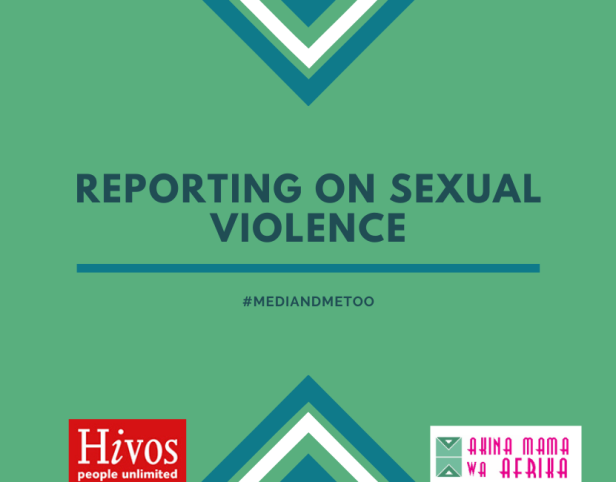
Akina Mama wa Afrika in partnership with Hivos hosted the #MediaandMeToo webinar from 11:00 AM-1:00 PM EAT on 28 March, 2020. The dialogue was held to assess the prevalence of Sexual Harassment in the media sector and to interrogate media’s documentation and reporting of cases of sexual harassment. The dialogue was also an opportunity to compel journalists, activists and users of online media to rethink and re-imagine the role of media in ensuring that victims of sexual violence receive justice and are not re-traumatized in the process.
After a captivating conversation, which you can watch here and/or read about here, the panelists proposed a list of good practices to take into account when interviewing survivors and while writing stories on sexual violence. They include:
Recommendations for Journalists
- Prepare yourself and your team for what could be a traumatic experience. Show solidarity without getting visibly upset in front of the survivor because the story is about them not you. Process any secondary trauma with the team after the interview.
- When speaking to the survivor, be open about who you are: your background, why you are qualified to report on their story, if you are recording the interview and let them know that you are recording the interview for your own notes and that the recording will not be shared anywhere if that is the case.
- Thank them for taking the time to speak with you and acknowledge the importance of the opportunity for them to speak with you.
- Believe the survivor. Unless you encounter overwhelming evidence to show that the survivor is lying or has reason to, as a feminist journalist you need to go into that interview, believing the survivor.
“As a feminist journalist, you need to go into that interview believing the survivor.” Alice McCool
- Allow them to tell their story at their own pace even though it takes longer or goes off topic. Leave room to take a break, offer them water or any other support and if you have encountered a similar experience and are able to, share in solidarity so they know that they are not alone.
- Weigh carefully when to interject with a question or seek for clarity and how far you can go with your line of questioning.
- Collaborate with women in the interviews for translation, photography etc. because research shows that survivors are more comfortable speaking to women.
- If a survivor has consented to use their name or photograph, you still need to judge if removing their anonymity is the right thing to do. If, for instance, a photograph is inappropriate you can find other ways of visualizing the story.
- Research the wider topic and back it up with reliable data. Contextualizing survivors’ stories makes them harder to dismiss and impossible to ignore.
- Ensure that at least 50% of the people you quote are women.
- Do investigative work for instance going undercover, speaking to lawyers and police, etc.
- It is important to strengthen the agency of the survivors and show their resistance instead of portraying them as passive for example Alice’s story about Kampala’s market women fighting back against sexual harassment.
- Remove yourself from the story and center the voices of survivors.
- Think about terminology. For example, the term ‘defilement’ which is popular in Uganda means, “Making something dirty or impure.” This should not be how children who are survivors of sexual violence are portrayed.
- Do not use overly graphic/over-sexualized language which may give the wrong impression, “Sexual violence is not sex, it is Violence.
- Work with editors to ensure what language should go in the story. Perpetrators have been known to use threats of legal action to silence victims or intimidate journalists from reporting about their abuse as they are often in positions of power so ensure you are protected from any legal action that may arise from the story.
- Share the story with activists, policy makers, influencers and a network of allies so that it can gain traction.
“Is your story inter-sectional? Have you considered the voices of sex workers, women with disabilities, LBTQ women, illiterate women and if you have, how have you represented them? Are we bringing our own biases to this reporting and how are we making sure that the reporting is fair?” Alice McCool
Recommendations for media organizations
- Media houses should include in their risk assessment questions like, “How often does sexual harassment happen to you, in your office or in the field?” Media houses need to be doing risk assessments and finding ways to protect women from sexual harassment without limiting the stories they take on.
- Every media institute should take time a year to audit their content and assess how often they’ve covered the issue of sexual harassment and how, given its prevalence.
- Media houses should ask audiences every year to share meaningful feedback on this kind of content.
- Media houses should curate reactions and feedback online and turn it into useful institutional knowledge that can be used to improve.
- Newsrooms should have women and equality desks focusing on more than lifestyle and health to include more political issues like sexual violence.
- Media houses like all other companies should create systems to handle sexual harassment complaints internally until their logical conclusion instead of handing off these matters to the Public Relations or Human Resources department where they are often overlooked.
Our vision is for media’s representation of cases of Violence against Women and Girls to change for the better. The reporting of an issue as sensitive as sexual violence should be guided by the feminist aspects of recognizing power dynamics, equity and justice, taking into account the critical role that the media plays in transforming societal norms.

